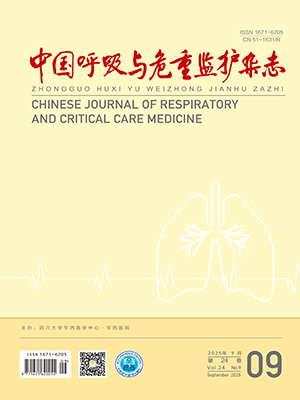| 1. |
邓小明, 王月兰, 冯艺, 等. (支)气管镜诊疗镇静/麻醉专家共识(2020版). 国际麻醉学与复苏杂志, 2021, 42(8): 785-794.
|
| 2. |
Ciriaco P. Impact of different sedation modalities on endobronchial ultrasound-guided transbronchial needle aspiration (EBUS-TBNA). Mediastinum, 2020, 4: 20.
|
| 3. |
Wahidi M, Jain P, Jantz M, et al. American College of Chest Physicians consensus statement on the use of topical anesthesia, analgesia, and sedation during flexible bronchoscopy in adult patients. Chest, 2011, 140(5): 1342-1350.
|
| 4. |
Sarkiss M. Anesthesia for bronchoscopy and interventional pulmonology: from moderate sedation to jet ventilation. Curr Opin Pulm Med, 2011, 17(4): 274-278.
|
| 5. |
Yang N, Jiang B, Jia Z, et al. To establish a risk prediction model for the occurrence of hypoxemia during painless bronchoscopy. Medicine, 2023, 102(46): e36164.
|
| 6. |
Tariq A, Hill N, Price L, et al. Incidence and Nature of Respiratory Events in Patients Undergoing Bronchoscopy Under Conscious Sedation. J Bronchology Interv Pulmonol, 2022, 29(4): 283-289.
|
| 7. |
Abdelmalak BB, Doyle DJ. Updates and controversies in anesthesia for advanced interventional pulmonology procedures. Curr Opin Anaesthesiol, 2021, 34(4): 455-463.
|
| 8. |
Ni YL, Lo YL, Lin TY, et al. Conscious sedation reduces patient discomfort and improves satisfaction in flexible bronchoscopy. Chang Gung Med J, 2010, 33(4): 443-452.
|
| 9. |
Putinati S, Ballerin L, Corbetta L, et al. Patient satisfaction with conscious sedation for bronchoscopy. Chest, 1999, 115(5): 1437-1440.
|
| 10. |
Frimas A, Zias N, Martinos C, et al. Dexmedetomidine-ketamine combination versus fentanyl-midazolam for patient sedation during flexible bronchoscopy: a prospective, single-blind, randomized controlled trial. BMC Pulm Med, 2024, 24(1): 301.
|
| 11. |
Huang C, Chou R, Hu G, et al. Patient experience with bronchoscopy: topical versus monitored anesthesia. BMC Pulm Med, 2024, 24(1): 164.
|
| 12. |
Frédérique S S, Bernard B, Roberto G, et al. Pharmacokinetics of propofol administered by target-controlled infusion to alcoholic patients. Anesthesiology, 2003, 99(3): 576-585.
|
| 13. |
Korpi ER, Sinkkonen ST. GABA(A) receptor subtypes as targets for neuropsychiatric drug development. Pharmacol Ther, 2006, 109(1-2): 12-32.
|
| 14. |
Thompson T, Oram C, Correll CU, , et al.Analgesic Effects of Alcohol: A Systematic Review and Meta-Analysis of Controlled Experimental Studies in Healthy Participants.J Pain, 2017, 18(5): 499-510.
|
| 15. |
Swerdlow BN, Holley FO, Maitre PO, et al. Chronic alcohol intake does not change thiopental anesthetic requirement, pharmacokinetics, or pharmacodynamics. Anesthesiology, 1990, 72(3): 455-461.
|
| 16. |
Døssing M. Effect of acute and chronic exercise on hepatic drug metabolism. Clin Pharmacokinet, 1985, 10(5): 426-431.
|




